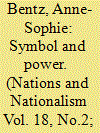|
|
|
Sort Order |
|
|
|
Items / Page
|
|
|
|
|
|
|
| Srl | Item |
| 1 |
ID:
120456


|
|
|
|
|
| Publication |
2013.
|
| Summary/Abstract |
When Afghans started fleeing abroad in the aftermath of the Saur Revolution of April 1978, Pakistan and Iran were the main countries of destination, but some Afghans also fled to India. This article offers new insights into one under-studied aspect of Indo-Afghan relations: population movements. What place have Afghan refugees occupied in Indo-Afghan relations (both formal and informal) from the Saur Revolution to the present? This article examines the specific situation of Afghan refugees in India, the general context of Indo-Afghan relations and India's ad hoc policy towards Afghan refugees, which all help explain the place occupied by Afghan refugees in Indo-Afghan relations.
|
|
|
|
|
|
|
|
|
|
|
|
|
|
|
|
| 2 |
ID:
111864


|
|
|
|
|
| Publication |
2012.
|
| Summary/Abstract |
This article originated in a brief but inspiring analysis by Margaret Nowak. Nowak used Sherry Ortner's concept of 'summarising symbol' to imply that, much the same way as the American flag was the epitome of the United States to each and every American, the Dalai Lama encompasses everything Tibetan to the Tibetan people. What does this comparison say about the Dalai Lama? I examine the relationship between symbol, power and charisma with Tenzin Gyatso, the current Dalai Lama, as a case in point. With exile, there has been a shift in the symbolic importance of the Dalai Lama, both as a man and as an institution, from a symbol of Tibet and Tibetan Buddhism to a symbol of the Tibetan cause and, more generally, to a symbol of Buddhism in the world. These changes have given Tenzin Gyatso a new authority in the Tibetan community: he is now the unique and unquestioned leader of the Tibetan cause in the world. I discuss the problems that occur when a symbol is also a man and a leader, as well as the solutions proposed, at a moment when the Tibetan community in exile is experiencing democratisation.
|
|
|
|
|
|
|
|
|
|
|
|
|
|
|
|
| 3 |
ID:
097818


|
|
|
|
|
| Publication |
2010.
|
| Summary/Abstract |
This article, mostly based on the information given to the authors by representatives of Tibetan Communities in Europe, focuses on Tibetans in Europe. It tackles the difficult question of statistical data before addressing the current situation of Tibetans in Europe, and more specifically in Switzerland, France and Germany, which constitute very different cases, both in terms of the socio-economic positions held by the Tibetans and in terms of the relationship established by the Tibetans with the countries of residence. It then deals with the link Tibetans in Europe have with the Tibetan Government-in-Exile, notably through the Offices of Tibet established in Geneva, Paris, Brussels and London. It also addresses the question of how Tibetans can work as a group in Europe. It thus looks at the type of connection that Tibetan associations and non-governmental organisations, Tibet support groups, as well as Tibetan monasteries and Buddhist centres can help establish between Tibetans throughout Europe. It concludes by examining the attraction of Europe to young Tibetans: what are indeed the new possibilities and challenges they face when coming to Europe?
|
|
|
|
|
|
|
|
|
|
|
|
|
|
|
|
|
|
|
|
|